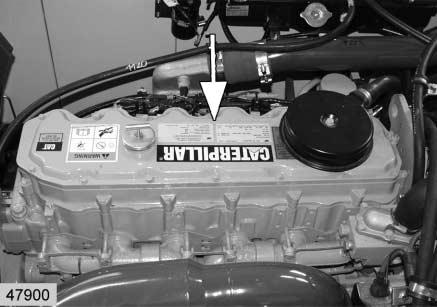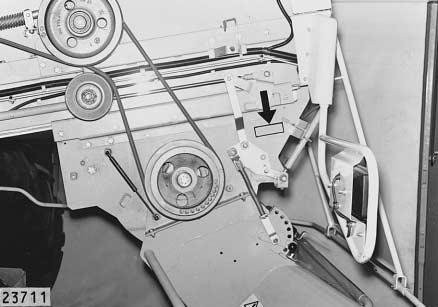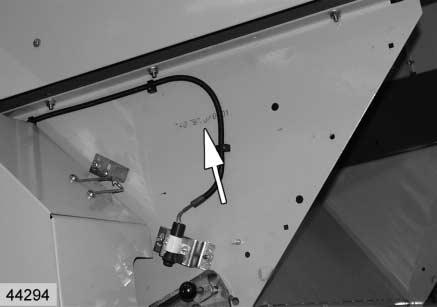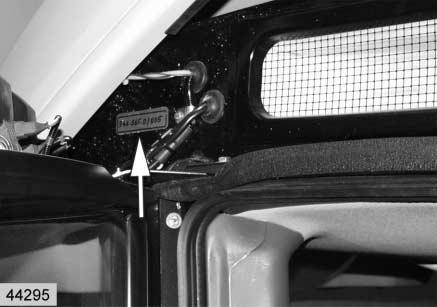
6 minute read
Access and ladder extension ........................................ 6.3
from Claas LEXION 460 / LEXION 450 LEXION 440 / LEXION 430 LEXION 420 / LEXION 410 IMO Operator's Manual
hydraulic

mechanic 5


6
7
8 Engine serial number
CATERPILLAR 3126 B
The identification plates showing the engine serial no. are attached to the valve cover. (Fig.5)
Straw chopper identification plate
The chopper serial number is stamped on the left hand side panel. (Fig.6,7)
Cabin serial number
The cabin serial number is located at the top of the left hand side, at the rear of the frame. (Fig.8)
4 Safety rules
SAFETY RULES
Before putting the machine into operation, read the operator's manual and follow the safety precautions!
Identification of warning and danger signs
All parts of this manual having to do with your safety or the safe operation of the machine are marked with the following signs. Please pass all safety instructions on to other users, too.
DANGER!
Sign to indicate instructions which must beobserved. Failure to do so would cause danger to life and limb to the operator and the people around him. ☞Preventive measures
ATTENTION!
Sign to indicate instructions which must beobserved. Failure to do so could result in damage to the machine. ☞Measures to prevent damage to the machine.
NOTE!
Sign to indicate instructions for a more effectiveand economic use of the machine.
ENVIRONMENT!
Sign to indicate instructions which must be observed in order to avoid damage to the environment. Danger to the environment is caused by irregular handling and incorrect disposal of toxic material (e.g. old oil).
The warning and instruction signs placed on thecombine provide recommendations for safe operation. These instructions involve your safety –observe them at all times!
Correct use of combine
This self-propelled combine is designed solely for use in customary agricultural operations (intended use). Use in any other way is considered as contrary to the intended use. The manufacturer accepts no liability for any damage or injury resulting from this misuse and these risks must be born solely by the user. Compliance and strict adherence to the conditions of operation, service and repair as specified by the manufacturer also constitute essential elements for the intended use. This combine should be operated, serviced and repaired only by persons familiar with all its particular characteristics and acquainted with the relevant safety rules (accident prevention). The accident prevention regulations, all other generallyrecognized regulations on safety and occupational medicine and the road traffic regulations must be observed at all times. Fitting and retrofitting of ancillary equipment which is not originally manufactured by CLAAS, and, in addition, also modifications and changes must only be carried out with the consent of CLAAS, as any such actions may have adverse affects on the safety and operational function of the machine. Any arbitrary modifications carried out on the combine will relieve the manufacturer of all liability for any resulting damage or injury.
General safety and accident prevention regulations
1.In addition to the instructions contained in this operator's manual, also observe the general safety and accident preventive regulations. 2.Always comply with local traffic regulations when driving on public roads. 3.Before starting work, familiarize yourself with allthe controls and instruments and their functions. During work or road travel it is toolate. 4.Before starting the engine ensure that the transmission is in neutral and that all guards are installed and in their correct position. 5.Start the engine only from the operator's seat.
Never attempt to start the engine by shortening across the starting motor terminals as the machine may immediately start to move!
6.Before moving away, always check the immediate vicinity of the machine (e.g. for children).
Ensure adequate visibility – for a warning, always blow the horn before starting up! 7.Never run the engine in a closed building! 8.Clothing worn by the operator must be closefitting! Avoid wearing loose jackets, shirts or ties. 9.Handle fuel with care as it is highly flammable.
Never refuel the machine in the vicinity of naked flames or sparks. Do not smoke during refuelling! 10.Always stop the engine and remove the main switch key (ignition key) before refuelling. Fill the fuel tank outdoors. Clean up any spilled fuel immediately! 11.Prevent fires by keeping the machine clean! 12.Take care when handling brake fluid and battery acid (toxic and corrosive). 13.Always blow the horn before starting the engine and engaging the threshing mechanism –watch for children!
Transporting passengers, co-driver, operating personnel
1.Passengers may only be carried if a proper passenger seat is fitted. 2.The carrying of passengers is otherwise not permitted!
Operation
1.Observe the maximum permissible axle loads and total weights. 2.The operating, steering and braking behaviour of the combine will be affected, e.g. by the road surface and by attaching implements. Therefore always adapt your speed to the terrain and ground conditions. It must be insisted that particular care is taken when operating and turning on a slope and when the grain tank is full.
Never take the transmission out of gear when driving on a slope or on uneven terrain! 3.The grain tank must be empty when driving on public roads and lanes. 4.Never leave the operator's platform / cabin when driving. 5.Stay a safe distance away from low over-head power lines (watch radio and CB radio antennas, if installed).
6.When driving on roads with a raised front attachment, the safety rocker switch must be switched off. 7.Before driving the machine and before starting fieldwork adjust the mirrors to give full view of the road or lane and working area behind!
Leaving the combine harvester
1.When leaving the combine harvester, ensure that it will not roll away (apply hand brake, chock blocks). Shut off the engine, remove the main switch key (ignition key) and lock the operator's cabin (if installed). – Turn off the battery isolating switch! 2.Never leave the combine unattended as long as the engine is still running. 3.Lower front attachments (cutterbars, maize picker head etc.) to the ground before leaving the combine.
Front attachments (cutterbar, maize picker head etc.) and other components
1.Work under raised attachments (cutterbar, maize picker head etc.) only when you are sure that the front attachment is safely supported! 2.Particular care must be taken when attaching front attachments (cutterbar, maize picker head etc.) or when coupling a trailer to the combine. 3.Knives, the cutterbar, intake auger and reel etc. cannot be completely shielded by constructional measures due to their function. Forthis reason, an adequate safety distance must be maintained to these moving elements during operation! 4.Gatherer chains and snapping rolls of the maize head (maize picker head) cannot be completely shielded by constructional measures due to their function. For this reason, an adequate safety distance must be maintained to these moving elements during operation also! These instructions apply analogously for all other attachments! 5.The straw chopper has safety guards surrounding dangerous rotating knives which continue to rotate for a while after the drive has been disengaged. For this reason, an adequate safety distance should be maintained to the straw chopper until the drive has come to a complete standstill. 6.The augers located inside the grain tank cannot be shielded completely against accidental contact due to their function. Use a rod to clear blockages and a scoop or similar vessel to take grain samples – never use your hands or feet.


